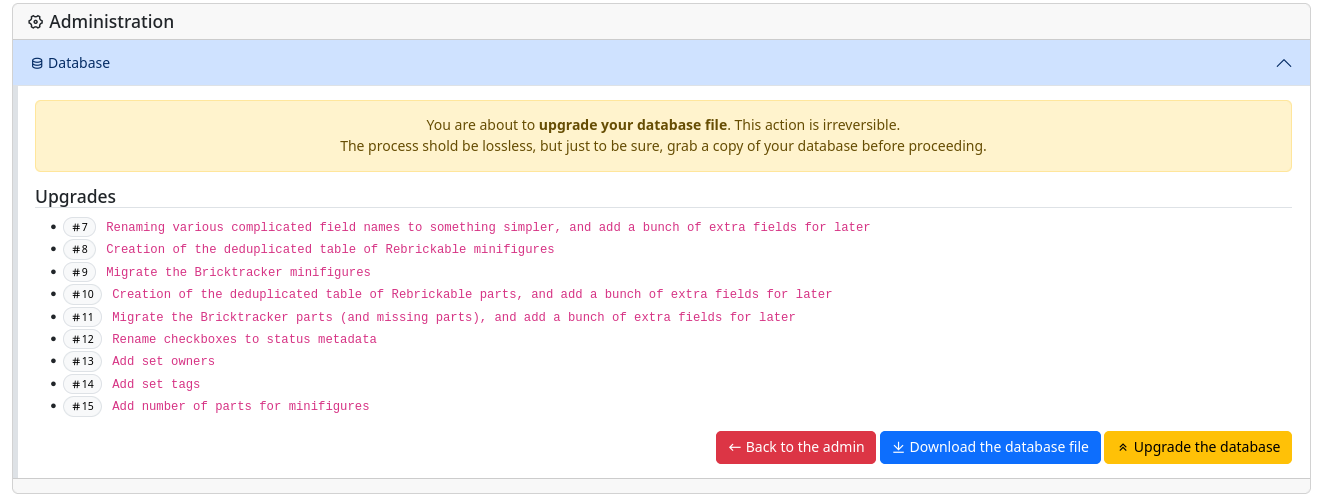-
released this
2025-02-06 20:32:43 +01:00 | 0 commits to master since this releaseBrickTracker 1.2.0
BrickTracker version 1.2.0 introduces better metadata support, improved part management, and enhanced UI controls. This release focuses on better organization through new storage features, purchase tracking, and ownership management.
How to Update
Assuming you are using Docker Compose to run BrickTracker, the update process depends on how you've configured your image tag.
Using latest tag
If your compose.yaml contains
image: gitea.baerentsen.space/frederikbaerentsen/bricktracker::latest, update with:# Pull the new version docker compose pull # Restart the container with the new image docker compose down docker compose up -dUsing version tag
If your compose.yaml specifies a version like
image: gitea.baerentsen.space/frederikbaerentsen/bricktracker::1.1.1:- Edit your compose.yaml and change the version to
1.2.0 - Run the following commands:
# Pull the new version docker compose pull # Restart the container with the new image docker compose down docker compose up -d
After updating, you'll be prompted to upgrade the database as described in the Database Upgrade section below.
Database Upgrade Required
On first launch, you'll need to upgrade the database:
- Click "Administration" when prompted
- Click "Upgrade the database"
- Download a backup of your database (strongly recommended)
- Click "Upgrade the Database" to complete the process
Your database version should now be at version 15 (location may vary based on your settings):
Major Features
Important Notes
⚠️ The "Missing" feature has been renamed to "Problems" to accommodate both missing and damaged parts. Related environment variables have been updated accordingly.
Metadata System
It is now possible to add additional information to each set:
- Set ownership tracking
- Purchase information (date, price, location)
- Storage location management
- Custom tags support
Values can be changed on the admin page:

Enhanced Parts Management
- Color information and transparency details
- Part relationships (prints, base parts)
- Damaged parts tracking
- Improved part visualization
- Minifigure part count calculation
Show/hide missing and damaged parts can be controlled using environment variables.
Set Management
- New data refresh system for Rebrickable integration
- Enhanced wishlist management with set requesters
- Track who requested each set using the Details button
- Requesters can be selected from the available owners list
- Option to hide instructions
- Improved bulk operations
Note
In version 1.2.0, BrickTracker expands the data it stores from Rebrickable's API. Previously, it only saved essential information, but now it stores more data including part colors and relationships.
Sets from earlier versions need their data refreshed to access these new features. A new admin section shows which sets require updating.Important:
- Updates use Rebrickable API calls
- Update sets gradually to avoid API rate limits
- After refresh, you'll see enhanced part details like colors and relationships
The refresh process populates all the new data fields, enabling features like color-coded part listings and print relationships in your set details.

UI Improvements
- Clear search functionality
- Enhanced form interactions and error handling
Environment Variables
Note
For a complete list of environment variables and their usage, see variables overview.New Variables
BK_HIDE_TABLE_MISSING_PARTS: Hide Missing columnBK_HIDE_TABLE_DAMAGED_PARTS: Hide Damaged columnBK_SHOW_GRID_SORT: Show sort options by defaultBK_SHOW_GRID_FILTERS: Show filter options by defaultBK_HIDE_ALL_STORAGES: Hide Storages menuBK_STORAGE_DEFAULT_ORDER: Storage orderingBK_PURCHASE_LOCATION_DEFAULT_ORDER: Purchase location orderingBK_PURCHASE_CURRENCY: Purchase price currencyBK_PURCHASE_DATE_FORMAT: Purchase date format
Renamed Variables
BK_HIDE_MISSING_PARTS→BK_HIDE_ALL_PROBLEMS_PARTS
See Changelog for more information.
Downloads
- Edit your compose.yaml and change the version to






